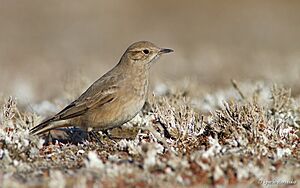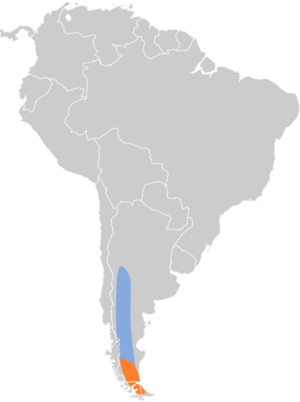Short-billed miner facts for kids
Quick facts for kids Short-billed miner |
|
|---|---|
 |
|
| Conservation status | |
| Scientific classification | |
| Genus: |
Geositta
|
| Species: |
antarctica
|
 |
|
The short-billed miner (Geositta antarctica) is a type of bird found in Argentina and Chile. It belongs to the ovenbird family called Furnariidae. This bird is known for its short beak, which helps it find food on the ground.
Contents
About the Short-billed Miner
Bird Family and Relatives
The short-billed miner is a unique bird, meaning it's the only one of its kind (monotypic). Even though it looks a lot like the common miner, its closest relative is actually the creamy-rumped miner.
What Does It Look Like?
The short-billed miner is a medium-sized bird. It is about 15 to 16 cm (6 inches) long. It weighs around 34 to 40 grams (1.2 to 1.4 ounces). Both male and female birds look the same.
Adult short-billed miners have a dull grayish-brown face. They have a light stripe above their eye and a darker line behind it. Their upper body is mostly grayish-brown. The feathers under their tail are whitish. The inner feathers of their tail are dark brown, and the outer three pairs are mostly white. Their wings are dark brown with a faint grayish band.
Their belly and chest are dull whitish. They have light buff-brown streaks on their chest. Their eyes are brown. Their short beak is blackish with a lighter base. Their legs and feet are also blackish. Young birds have pale tips on their head feathers. Their chest streaks are not as clear as those on adult birds.
This bird lives in some of the same areas as the common miner. You can tell them apart because the short-billed miner has a much shorter beak. It also does not have any reddish-brown color on its flight feathers.
Where the Short-billed Miner Lives
Geographic Range
The short-billed miner is one of the birds that nests furthest south in the world. It mostly breeds in Argentina, especially on Tierra del Fuego. It also breeds in smaller numbers in southern Santa Cruz Province in Argentina. You can also find it breeding in southern Chile's Magallanes Region. When it's not breeding season, some birds fly north. They can go as far as Mendoza Province in western Argentina.
Natural Home
The short-billed miner lives in the Patagonian Steppe. This area has flat, open plains with thin grasses and scattered bushes. It also lives in grassy areas that are a bit warmer. Sometimes, you can find them in sandy areas along the coast. They live from sea level up to about 1,000 meters (3,300 feet) high.
How the Short-billed Miner Behaves
Movement and Migration
Short-billed miners live year-round on Tierra del Fuego and the southern mainland. Some birds move further north in Argentina after they have finished breeding.
What Do They Eat?
Short-billed miners usually look for food alone or in pairs. They eat arthropods (like insects) and seeds. They pick their food directly from the ground.
Reproduction and Nesting
The short-billed miner breeds during the summer in the Southern Hemisphere. This is usually from November to January. Scientists believe they stay with one partner for life.
They build their nests in tunnels. These tunnels are dug into the side of a sand dune or an earthen bank. At the end of the tunnel, there is a nest chamber. They line this chamber with grasses. A female bird usually lays three eggs. These birds have been seen nesting in groups with other types of ovenbirds.
Bird Calls and Songs
The short-billed miner's song sounds like "weetuk-weetuk-weetuk-weetuk-weetuk." When it flies, its call is a sharp sound like "tjeek, de trrrit, trritrritrritrritrrie."
Status of the Short-billed Miner
The IUCN (International Union for Conservation of Nature) says the short-billed miner is a species of "Least Concern." This means it is not currently in danger of disappearing. It lives in a fairly large area. Even though we don't know the exact number of birds, their population seems to be stable.
There are no immediate threats to the short-billed miner. However, changes to its habitat due to climate change might affect it in the future. This bird is considered to be quite common in its habitat. Its home seems safe from human activities, except for too much grazing by animals.


